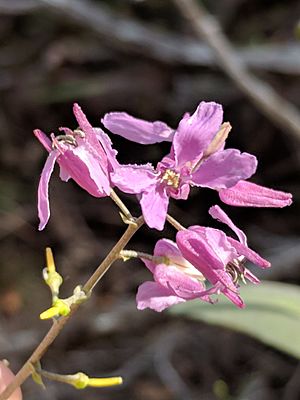Bracted jewelflower facts for kids
Quick facts for kids Bracted jewelflower |
|
|---|---|
 |
|
| S. bracteatus in Travis County, Texas, US | |
| Conservation status | |
| Scientific classification | |
| Genus: |
Streptanthus
|
| Species: |
bracteatus
|
The Streptanthus bracteatus is a special kind of flowering plant. It is often called the bracted jewelflower or bracted twistflower. This plant belongs to the mustard family, just like broccoli or cabbage!
This plant is found only in Texas in the United States. When a plant or animal is found only in one specific area, we say it is endemic to that place.
What Does It Look Like?
The bracted jewelflower is an annual or biennial plant. This means it either lives for one year (annual) or two years (biennial). It grows a stem that can reach up to 1.2 meters (about 4 feet) tall.
Stems and Leaves
The plant's stem is usually smooth and has a slightly waxy feel. The leaves at the bottom of the plant are called basal leaves. They have long stems, called petioles, and their edges can be wavy or toothed. Leaves higher up on the stem usually have smooth edges.
Flowers and Fruits
The flowers grow in a cluster called a raceme. This is like a long stalk with flowers blooming along its sides. Each flower has four purple petals that can be almost 2 centimeters (about 0.8 inches) long. They also have a bell-shaped part made of small leaves called sepals.
After the flowers bloom, the plant produces a long, flat fruit. This fruit is called a silique. It can grow up to 14.5 centimeters (about 5.7 inches) long!
Where Does It Grow?
This unique plant grows naturally in Texas. You can find it along the Balcones Escarpment and on the Edwards Plateau. These are specific areas in Texas with certain types of land.
The bracted jewelflower likes to grow in clay soils. It can be found in different kinds of natural areas. Sometimes, it grows in places where thick bushes protect it from animals that might want to eat it. This protection helps the plant survive and thrive.


